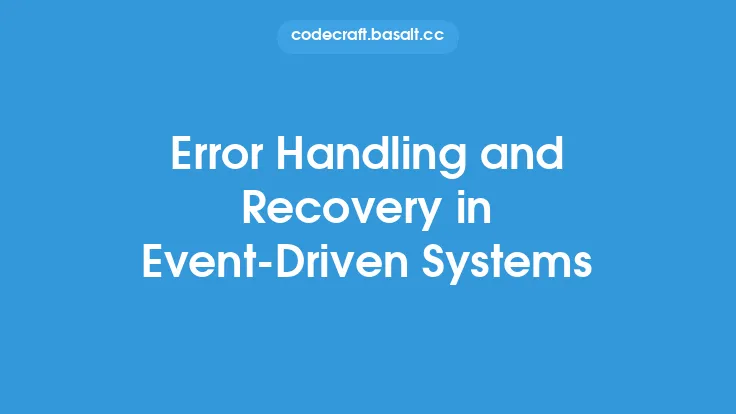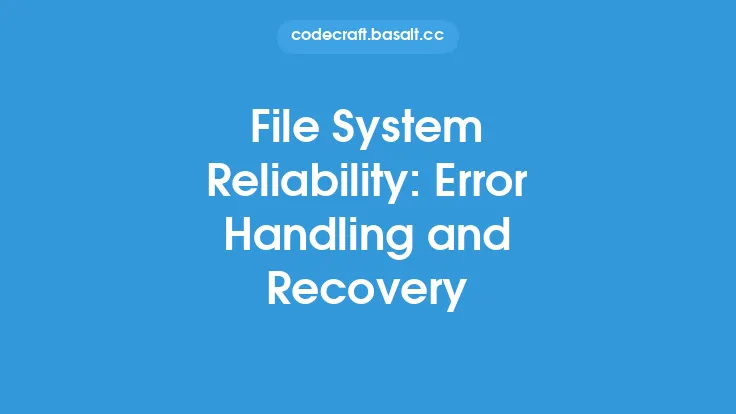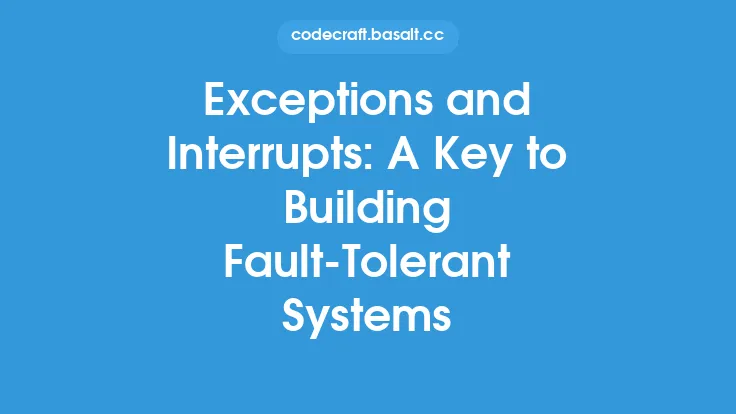When designing and implementing microservices-based systems, it's essential to consider the inherent complexities and potential pitfalls that can arise from the distributed nature of these architectures. One critical aspect of building resilient microservices is the implementation of robust error handling and fault tolerance mechanisms. These mechanisms enable individual services to recover from failures, maintain overall system stability, and ensure a high level of availability, even in the face of unexpected errors or service disruptions.
Introduction to Error Handling in Microservices
Error handling in microservices is a critical component of building resilient systems. Unlike monolithic applications, where errors are typically contained within a single process, microservices introduce additional complexity due to their distributed nature. When a service fails or encounters an error, it can have a ripple effect throughout the system, potentially leading to cascading failures if not properly handled. Effective error handling strategies in microservices involve detecting errors, preventing error propagation, and implementing recovery mechanisms to minimize the impact of failures on the overall system.
Fault Tolerance in Microservices Architecture
Fault tolerance is the ability of a system to continue operating correctly even when one or more of its components fail. In the context of microservices, achieving fault tolerance involves designing services that can detect and recover from failures without significantly impacting the system's overall functionality. This can be achieved through various strategies, including service redundancy, where multiple instances of a service are deployed to ensure that if one instance fails, others can continue to operate. Another approach is to implement circuit breakers, which detect when a service is not responding and prevent further requests from being sent to it until it becomes available again, thereby preventing cascading failures.
Implementing Error Handling Mechanisms
Implementing effective error handling mechanisms in microservices requires a combination of design principles, patterns, and technologies. One key principle is to ensure that services are designed to fail fast, allowing them to quickly detect and respond to errors rather than attempting to recover from them internally. This approach enables the system to isolate the failure and prevent it from affecting other services. Additionally, services should be implemented with idempotence in mind, meaning that even if a service is called multiple times with the same input, it will have the same effect as if it were called only once. This property is crucial for ensuring that retries, which are a common error handling strategy, do not lead to inconsistent system states.
Role of Service Discovery and Load Balancing
Service discovery and load balancing play critical roles in error handling and fault tolerance in microservices. Service discovery mechanisms allow services to register themselves and be discovered by other services, enabling the system to dynamically adjust to changes in service availability. Load balancing, on the other hand, distributes incoming requests across multiple service instances, helping to prevent any single instance from becoming overwhelmed and failing due to high load. By combining service discovery with load balancing, the system can automatically redirect requests away from failed service instances to healthy ones, minimizing the impact of failures on the system's overall availability.
Distributed Transaction Management
In microservices architectures, transactions often span multiple services, making distributed transaction management a complex challenge. When a service fails during a transaction, it can leave the system in an inconsistent state, requiring mechanisms to detect and recover from such failures. One approach to managing distributed transactions is to use saga patterns, which model a transaction as a series of local transactions, each of which can be rolled back if any part of the transaction fails. Another strategy is to use event sourcing, where the state of the system is stored as a sequence of events, allowing the system to recover to a consistent state by replaying these events in case of a failure.
Monitoring and Logging for Error Detection
Monitoring and logging are essential for detecting errors and understanding the behavior of microservices. By implementing comprehensive monitoring and logging mechanisms, developers can quickly identify when services are failing or behaving unexpectedly, allowing for swift action to be taken to mitigate the issue. Logs should be centralized and easily accessible, providing detailed information about service interactions and errors. Monitoring tools should be capable of detecting anomalies in service behavior, such as increased error rates or response times, and alerting teams accordingly.
Testing for Resilience
Testing microservices for resilience involves more than just unit testing and integration testing; it requires simulating real-world failure scenarios to ensure that the system can recover from them. This can be achieved through chaos engineering, a practice that involves intentionally introducing failures into a system to test its resilience. By simulating various failure scenarios, such as network partitions, service failures, and high latency, developers can identify weaknesses in the system's error handling and fault tolerance mechanisms and improve them before they are encountered in production.
Conclusion
Building resilient microservices requires a multifaceted approach that encompasses error handling, fault tolerance, service discovery, load balancing, distributed transaction management, monitoring, logging, and comprehensive testing. By understanding the complexities of microservices architectures and implementing strategies to mitigate the risks associated with their distributed nature, developers can create systems that are highly available, scalable, and capable of recovering from failures with minimal impact on users. As microservices continue to play a critical role in modern software development, the importance of robust error handling and fault tolerance mechanisms will only continue to grow, making them a foundational aspect of building resilient and reliable systems.





